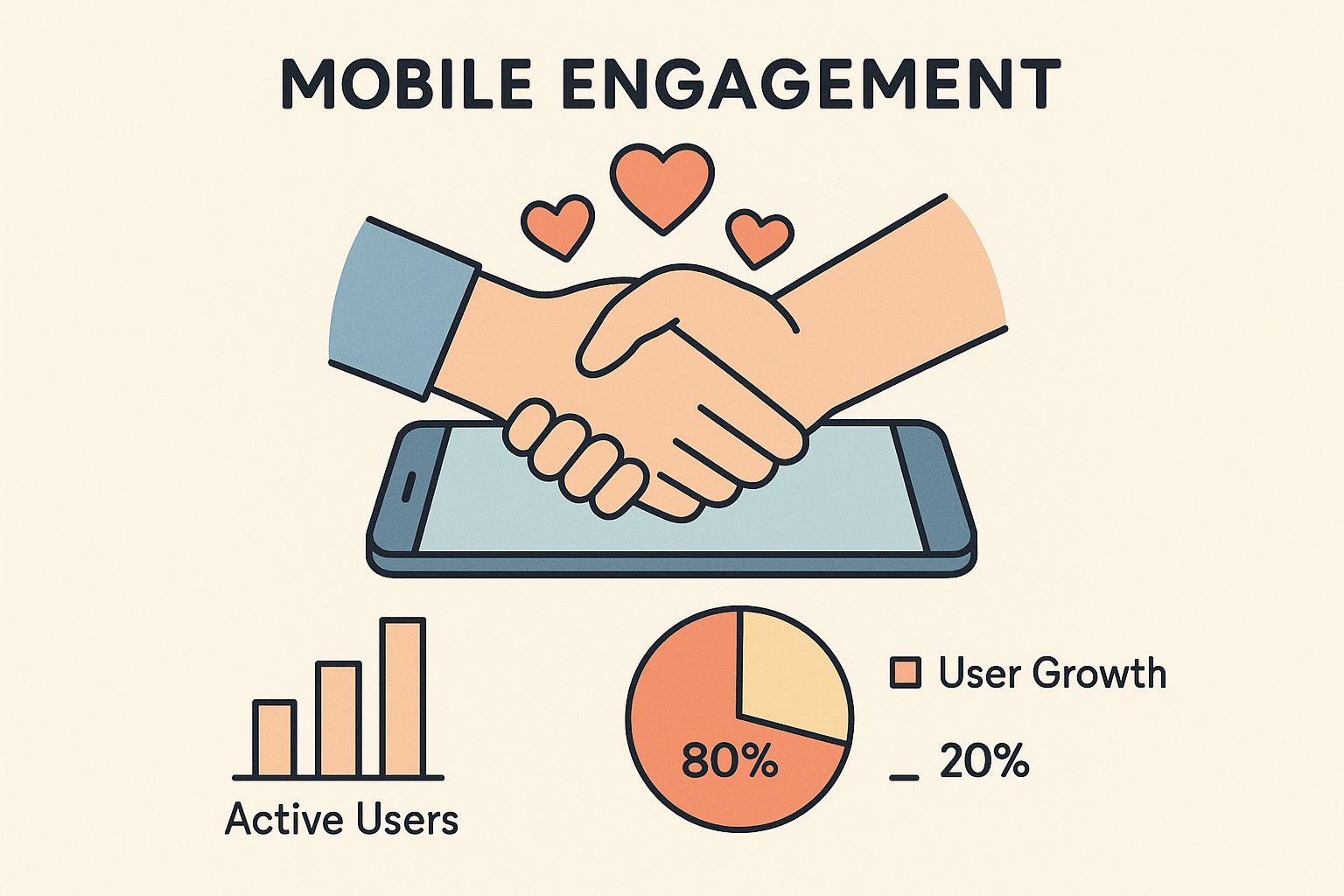
Influencer Relationship Management: Key Strategies for Success
Published
The Evolution of Influencer Relationship Management

The days of one-off paid celebrity endorsements are gone. Influencer Relationship Management (IRM) has changed significantly, moving from simple transactions to strategic, long-term partnerships. Brands are realizing that authentic, ongoing relationships with influencers produce much better results than occasional campaigns. This means building real connections with creators whose values align with the brand and who truly resonate with the target audience.
From Transactions to Partnerships
Influencer marketing used to be treated like a simple media purchase. However, this approach is outdated. Today, successful influencer marketing depends on nurturing genuine relationships. Brands are collaborating with influencers on content creation, incorporating their feedback during product development, and even including them in broader brand initiatives. This collaborative approach builds trust and authenticity, leading to more effective campaigns.
The Rise of the Influencer Ecosystem
Forward-thinking brands are going beyond individual campaigns to create comprehensive influencer ecosystems. These ecosystems involve a diverse range of influencers, from mega-influencers with huge followings to micro-influencers with dedicated niche audiences, all working together to amplify the brand's message. Tools are readily available to help influencer marketers manage these complex networks. This combined approach generates a powerful ripple effect, with each influencer contributing to a larger, more impactful brand story.
The Importance of Long-Term Value
As the influencer marketing industry grows, so does the importance of influencer relationship management. The global influencer marketing market is expected to reach $32.55 billion by 2025, a significant increase from $24 billion in 2024 and a dramatic leap from $1.4 billion in 2014. This growth highlights the need for strong relationship management strategies to maximize returns. More statistics can be found here.
For example, brands are now seeing a return of $4.12 for every $1 spent on Instagram influencer campaigns. This impressive ROI demonstrates the potential of well-managed influencer partnerships. With 80% of companies now allocating a portion of their marketing budget to influencers, it’s clear that influencer marketing has become a strategic necessity across diverse industries. This shift underscores the importance of long-term influencer relationships for sustainable growth. These ongoing partnerships cultivate brand loyalty and provide consistent, high-quality content that drives stronger business results. The evolution of IRM represents a fundamental change in how brands view and interact with influencers, recognizing them not just as media channels, but as true partners in achieving business goals.
Building the Foundation for Lasting Creator Partnerships
What separates brands that influencers clamor to work with from those they avoid? The answer lies in Influencer Relationship Management (IRM). It's more than contracts and free products; it's about nurturing genuine connections rooted in mutual respect and understanding.
Clear Communication: The Cornerstone of Collaboration
Effective communication is the bedrock of any successful partnership. This involves establishing clear feedback channels, responding promptly to inquiries, and maintaining open dialogue throughout the collaboration. Just like constructing a building, without solid communication, the entire project is at risk.
Leading brands use platforms like Slack to centralize communication, keeping everyone informed. Regular check-ins are scheduled not only for deliverables but also to understand the influencer’s perspective and address any potential concerns.
Comprehensive Briefs: Inspiring, Not Restricting
While brand guidelines are important, overly restrictive briefs can stifle creativity. The goal is to provide a framework while still allowing the influencer’s unique voice and style to shine. This balance fosters authenticity, a key element of influencer marketing success. Learn more in our article about How to master influencer marketing best practices.
Provide detailed campaign objectives, target audience information, and key messaging, but also invite influencers to share their ideas. This collaborative approach results in more engaging and impactful content.
Contracts: Protecting Creativity, Not Stifling It
Contracts are essential for setting clear expectations and protecting both the brand and the influencer. However, agreements shouldn't feel restrictive. Instead, they should facilitate smooth collaboration, ensuring transparency around legal aspects while building trust and mutual benefit.
Clearly outlining payment terms, usage rights, and content approval processes upfront prevents future misunderstandings. Including clauses that address creative autonomy empowers influencers to produce their best work.
Organizational Capabilities: Nurturing Long-Term Growth
Lasting influencer relationships require more than individual effort; they require organizational commitment. Brands need to invest in the infrastructure and processes that support effective IRM. This includes dedicated teams, streamlined workflows, and the right technology to manage communication, track deliverables, and measure performance.
Having systems in place for identifying and vetting potential influencer partners, onboarding new collaborators, and nurturing ongoing relationships is vital. Treating influencers as valued partners allows brands to build a strong network of advocates who authentically champion their message and contribute to long-term success. You might be interested in: How to Master....
The following table outlines the key components of a successful IRM strategy. It details how each element contributes to mutually beneficial partnerships.
Core Elements of Influencer Relationship Management
| Component | Purpose | Implementation Strategies | Success Indicators |
|---|---|---|---|
| Clear Communication | Build trust and ensure alignment | Utilize communication platforms (e.g., Slack), schedule regular check-ins, establish clear feedback channels | High influencer satisfaction, on-time delivery of content, minimal revisions |
| Comprehensive Briefs | Guide creative development while allowing for flexibility | Provide detailed briefs outlining campaign goals and key messaging, encourage influencer input and feedback | High-quality, engaging content that aligns with brand messaging, positive campaign performance |
| Contracts | Establish clear expectations and protect both parties | Clearly define payment terms, usage rights, and content approval processes; incorporate clauses addressing creative autonomy | Smooth collaboration, minimal disputes, mutually beneficial outcomes |
| Organizational Capabilities | Streamline processes and foster long-term growth | Dedicated IRM team, efficient workflows, robust technology for communication and performance tracking | Long-term influencer partnerships, high influencer retention rate, successful campaigns |
By focusing on these core elements, brands can cultivate stronger, more effective influencer partnerships that drive impactful results.
Micro-Influencer Magic: Maximizing Engagement Through Authenticity
While macro-influencers boast extensive reach, many brands are realizing the remarkable impact of micro-influencers. These individuals cultivate smaller, yet highly engaged audiences, often outperforming their more famous counterparts. Let's delve into why micro-influencers are so effective and how to build authentic relationships with them.
The Power of Authenticity and Engagement
Micro-influencers excel at fostering a strong sense of community within their specific niche. This close connection translates into impressive engagement rates because their followers see them as relatable and trustworthy. Their recommendations come across less like advertisements and more like genuine advice from a friend. This organic authenticity resonates deeply, forging connections that inspire action. Learn more about breaking into the field: How to get into influencer marketing.
Identifying the Perfect Partners
Selecting the right micro-influencers goes beyond mere follower counts. The focus should be on audience quality, content resonance, and authentic alignment with your brand’s values. Look for creators whose audience demographics mirror your target market and whose content genuinely reflects your brand’s message. This strategic alignment ensures your message reaches the right audience authentically.
Managing Multiple Relationships
Managing personalized relationships with numerous micro-influencers might seem overwhelming. However, scalable strategies exist that prioritize quality without compromising personal touch. Influencer Relationship Management (IRM) tools, for example, can streamline communication, track deliverables, and measure performance, enabling brands to manage multiple campaigns while nurturing individual creator relationships. HubSpot offers a variety of tools to support marketing initiatives.

This infographic illustrates the collaborative relationship between brands and influencers. Two hands shaking over a smartphone, combined with heart notifications, symbolizes strong engagement through personalized connection and genuine interaction. The image emphasizes that strong relationships, not mere transactions, fuel impactful influencer marketing results.
Turning Micro-Influencers into Brand Advocates
Micro-influencers possess the potential to evolve into true brand advocates, extending their efforts beyond sponsored posts to champion your brand organically. Cultivating long-term relationships based on mutual trust and respect is key. Providing exclusive access to new products, involving them in product development, and publicly acknowledging their contributions can transform partnerships into lasting brand advocacy.
To understand the nuances of different influencer tiers, consider the following comparison:
Influencer Tier Comparison This table compares different influencer tiers based on audience size, engagement rates, and management considerations.
| Influencer Type | Audience Size | Average Engagement Rate | Cost Range | Management Complexity |
|---|---|---|---|---|
| Nano | 1,000 - 10,000 | 5% - 10% | $50 - $250 per post | Low |
| Micro | 10,000 - 100,000 | 2% - 5% | $250 - $1,000 per post | Medium |
| Macro | 100,000 - 1,000,000 | 1% - 2% | $1,000 - $10,000+ per post | High |
| Mega | 1,000,000+ | <1% | $10,000+ per post | Very High |
This table highlights the inverse relationship between audience size and engagement rate. While mega-influencers have the largest reach, nano and micro-influencers often generate higher engagement. Managing multiple micro-influencers can be more complex than managing a single macro-influencer, but the potential for authentic engagement and brand advocacy often outweighs this challenge.
Micro-influencers play a crucial role in influencer relationship management due to their high engagement rates. As of 2024, nano-influencers, a subset of micro-influencers, represented 75.9% of Instagram’s influencer base. This demonstrates a growing trend towards smaller-scale influencers for personalized content and higher engagement. For further insights into these trends, explore detailed statistics here. Effective management hinges on understanding each influencer type and adapting strategies to leverage their specific audience effectively.
Tech Tools That Transform Influencer Relationships

Managing influencer partnerships with spreadsheets and endless email chains isn't ideal. Thankfully, Influencer Relationship Management (IRM) tools exist to help. These platforms empower brands to cultivate authentic and impactful influencer relationships.
Streamlining Influencer Discovery and Vetting
Finding the right influencers is crucial for successful IRM. Specialized tools simplify this with extensive databases of potential partners. Detailed profiles showcase audience demographics, engagement rates, and past collaborations. This streamlines influencer discovery, letting brands target creators aligned with their campaign goals and target audience.
For brands working with micro-influencers, dedicated platforms can be particularly helpful. Check out this guide on micro-influencer platforms for more information. These platforms often include sophisticated search filters. Brands can narrow down potential partners by keywords, industry, audience location, and more. Some tools even offer sentiment analysis, helping brands assess an influencer’s online reputation.
Automating Communication and Workflow
Effective communication is essential for strong influencer relationships. IRM platforms centralize all communication, from initial outreach to ongoing campaign management. This system helps track conversation history, schedule automated follow-ups, and manage multiple collaborations at once.
Many platforms also provide automated reporting, offering real-time campaign progress and influencer performance updates. This reduces manual work and frees up time for strategic relationship building.
Tracking Deliverables and Measuring Performance
Tracking influencer deliverables, like content creation and posting schedules, is key for keeping campaigns on track. IRM tools offer features for managing timelines, tracking deadlines, and ensuring accountability. This prevents delays and miscommunication, fostering seamless collaboration.
These platforms also offer robust analytics dashboards to measure campaign performance. Going beyond vanity metrics like likes and followers, these tools track website traffic, conversions, and sales. This data-driven approach helps brands assess the ROI of their influencer marketing and optimize future campaigns. Choosing the right tools depends on team size, campaign complexity, and budget. Investing in the right IRM tools is essential for scaling influencer marketing and building lasting creator partnerships.
Measuring What Matters in Creator Relationships
Moving beyond likes and comments opens a world of deeper insights into the true value of your influencer partnerships. This means looking at the overall health and effectiveness of the relationship itself, rather than just focusing on individual campaign metrics. Smart brands are using specific frameworks to evaluate these vital connections, understanding that strong relationships are the engine of long-term success in influencer marketing.
Beyond Vanity Metrics: Assessing Relationship Health
Standard dashboards often miss the nuances of creator relationships. While engagement metrics offer a snapshot of content performance, they don't reveal the full picture. Content quality consistency, for instance, demonstrates an influencer's commitment to maintaining high standards, indicating a strong and reliable partnership.
Similarly, response time patterns can signal an influencer's responsiveness and dedication to collaboration. These subtle indicators are essential for assessing the health of the relationship.
Additionally, tracking audience sentiment shifts provides insights into how an audience perceives the partnership. A positive shift suggests the collaboration feels authentic and resonates with the target audience. Conversely, negative trends could indicate a mismatch or potential issues requiring attention.
Balanced Scorecards: Quantifying the Qualitative
To effectively capture both the quantitative and qualitative aspects of influencer relationships, many brands are developing balanced scorecards. These scorecards combine traditional performance metrics with relationship-specific indicators.
This approach provides a holistic view of the partnership. It allows brands to assess the overall value generated beyond immediate campaign results. For example, a balanced scorecard might include metrics like long-term ROI, reflecting the sustained impact of a strong relationship over time.
It also includes qualitative assessments of communication effectiveness and collaboration quality.
Tracking Without Overburdening: Practical Systems
Building robust tracking systems doesn’t necessitate complex processes. Many brands are implementing streamlined processes to monitor key relationship metrics without creating an administrative burden.
This can involve leveraging Influencer Relationship Management (IRM) software to automate data collection and reporting. Some brands also use shared dashboards to maintain transparency and facilitate ongoing communication with their influencer partners.
Communicating Value to Stakeholders
Demonstrating the value of relationship-building activities to stakeholders focused on short-term gains can be challenging. This requires clear communication and compelling data.
By showcasing the link between strong relationships and long-term ROI, brands can justify investments in activities that foster deeper connections with influencers. Sharing case studies and success stories highlighting how relationship-focused approaches have delivered exceptional results can be particularly effective.
This helps persuade stakeholders to adopt a long-term perspective. You might be interested in: How to Master Influencer Marketing KPIs. By focusing on these key aspects of measurement, brands can gain a more comprehensive understanding of the true value of their influencer relationships and build stronger partnerships that drive sustainable growth.
Navigating Relationship Challenges With Confidence
Even the strongest influencer partnerships face obstacles. This section explores common relationship challenges and provides practical solutions based on real-world experience. We’ll discuss resolving creative differences, addressing performance issues, navigating exclusivity requests, and managing disclosure requirements in the constantly evolving world of influencer marketing.
Addressing Creative Differences
Creative differences are unavoidable. The key is addressing them constructively without damaging the relationship. This requires open communication and a willingness to compromise. For example, if an influencer's content strays from the agreed-upon direction, start a conversation focused on understanding their perspective. The goal is finding a mutually agreeable path forward.
Remember, influencers are creative professionals. Respecting their artistic vision while ensuring alignment with your brand's message is crucial. This often involves finding a middle ground that satisfies both sides.
Managing Performance Issues
Sometimes, influencers might not meet performance expectations. This could involve missed deadlines, low-quality content, or underperforming campaigns. Addressing these issues promptly and constructively is essential.
Start by clearly communicating your concerns, providing specific examples. Then, collaborate with the influencer to identify the root cause and develop a plan for improvement. This collaborative approach strengthens the partnership while addressing the performance gap.
Navigating Exclusivity Requests
Exclusivity requests, where an influencer works solely with your brand within a specific category, can be tricky. Carefully consider the potential advantages and disadvantages before agreeing to such arrangements.
Evaluate the influencer's fit with your brand, their reach within your target audience, and the potential impact on your overall influencer marketing strategy. Clearly define the terms of any exclusivity agreement, including the duration, scope, and compensation.
Handling Disclosure Requirements
Transparency and compliance with disclosure requirements are vital in influencer marketing. Regulations regarding sponsored content are constantly changing. Staying informed and ensuring your influencer partners are also aware of these regulations is critical.
Provide clear guidelines to influencers on disclosure best practices and monitor their content to ensure compliance. This proactive approach protects both your brand and the influencer from potential legal problems.
Turning Challenges into Opportunities
Successfully navigating relationship challenges can strengthen partnerships. Addressing issues openly and finding collaborative solutions builds trust and mutual respect. This can lead to more effective collaborations and a stronger, more resilient relationship.
View these challenges as opportunities for growth and development within the partnership. Implementing clear communication strategies and fostering a collaborative environment can transform potential breaking points into opportunities for relationship building. This could include regular feedback sessions, clearly defined performance expectations, and strategies for ongoing communication.
Find your perfect influencer marketing job today! Visit Influencer Marketing Jobs to explore diverse opportunities, from entry-level to senior leadership roles. Sign up for our weekly email list for personalized job recommendations tailored to your skills and experience.